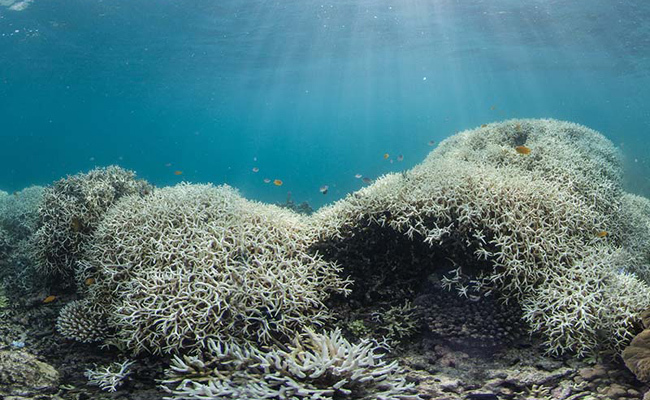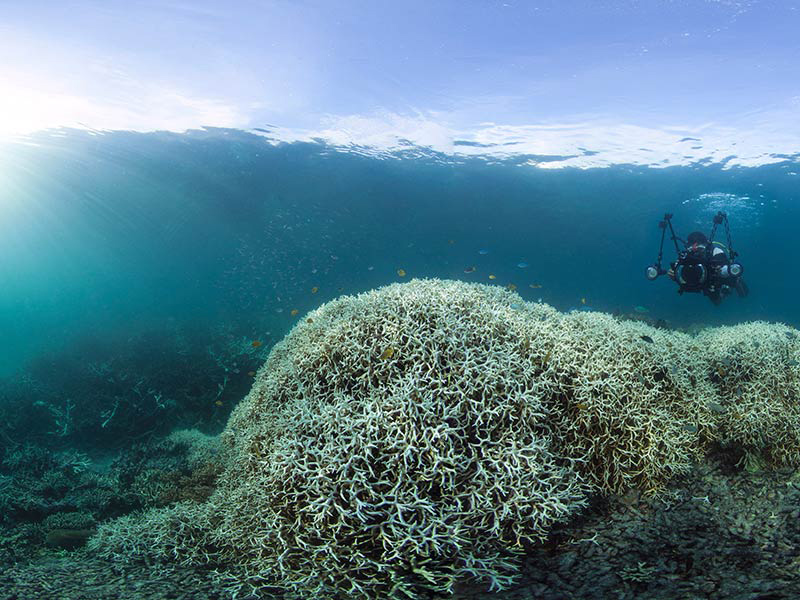
Date: 2025-10-14 Page is: DBtxt003.php txt00015061
Oceans
Water changes in the oceans
Coral Bleaching in the Great Barrier Reef Reaches Concerning New Level
Burgess COMMENTARY
Peter Burgess
Coral Bleaching in the Great Barrier Reef Reaches Concerning New Level

Images of coral bleaching across Australia’s iconic Great Barrier Reef have led to authorities stepping up their response plan and conservationists calling for more to be done to protect the reef from further damage driven by climate change.
The Great Barrier Reef is the world’s largest coral ecosystem that is a valuable marine ecosystem, providing homes for thousands of species, and is also a protected World Heritage Site. Now, it’s unfortunately being threatened by climate change, which is causing a severe and worrying bleaching event.
According to WWF Australia, which released images and video footage this week that were taken around Lizard Island by a CoralWatch team led by Professor Justin Marshall from the University of Queensland and the XL Catlin Seaview Survey show what’s being called the worst bleaching event in 15 years.

Credit: XL Catlin Seaview Survey
“The new video and stills are very concerning and show large sections of coral drained of all colour and fighting for survival,” said WWF spokesperson Richard Leck. “This is the worst coral bleaching event ever to hit this most pristine part of the Great Barrier Reef.”
Coral has a symbiotic relationship with tiny algae, known as zooxanthellae, that provide it with food and give it its color. When coral is stressed because of high ocean temperatures, or other causes like pollution and acidification, it expels the algae living in its tissues, which exposes its white skeleton. It may recover if stressors are reduced, but if they continue the coral will die.

Credit: XL Catlin Seaview Survey
In response to severe bleaching, the Great Barrier Reef Marine Park Authority lifted its response to level three, the highest level in its coral bleaching response plan, and will be increasing surveys to explore the extent of the damage along the northeast coast.
“We still have many more reefs to survey to gauge the full impact of bleaching, however unfortunately, the further north we go from Cooktown, the more coral mortality we’re finding,” Marine Park Authority Chairman Dr. Russell Reichelt said in a statement. “The corals in the remote far north of the Reef experienced extremely hot and still conditions this summer, and were effectively bathed in warm water for months, creating heat stress that they could no longer cope with.”
While WWF Australia is applauding the response, it’s also calling for immediate action to help the reef recover and reduce the threat of climate change.
“We can turn this around. The Reef can recover but we must speed up the shift to clean, renewable energy and we must build reef resilience by reducing runoff pollution from farms and land clearing,” said Leck. “Australia must speed up the transition to clean energy – like solar and wind – by setting a target of 100% renewable electricity by 2035.”
As conservationists call for more to be done to save the Great Barrier Reef, they’re also raising concerns about how bleaching is going to impact corals around the world. As National Geographic points out, over the last year, about 12 percent of the world’s reefs have bleached because of climate change, which has been exacerbated by El Niño, is expected to lead to the longest bleaching event around the world yet.
Photo credit: XL Catlin Seaview Survey/WWF Australia